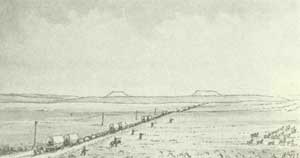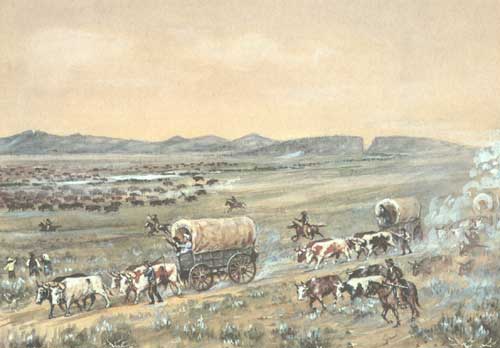
INTRODUCTION
By Marian Albright Schenk
FOREWORD
By Dean Knudsen
SECTION 1
Primary Themes of Jackson's Art
SECTION 2
Paintings of the Oregon Trail
SECTION 3
Historic Scenes From the West
 |
| In 1884, like thousands of people before and since, William Henry Jackson simply could not resist the temptation to be photographed standing on the outcropping of Glacier Point in Yosemite. (SCBL 1018) |

Section 2: Paintings of the Oregon Trail
THE DEVIL'S GATE
Devil's Gate is a long, narrow gorge that has been cut through a ridge of solid rock. While the Sweetwater River is able to make its way through, the cut is impassible to road traffic, and emigrant wagons had to swing south of the river. Devil's Gate is visible for miles and was the topic of much speculation among the overland emigrants.
Some early pioneers, who camped nearby and must have had time on their hands climbed into the Gate and marveled at the echoes they could generate. Some even carved their names in the walls. In 1866, Jackson made little mention of Devil's Gate, and one can only assume that he was working very hard and consumed with the increasing tensions among his fellow teamsters.
In the early summer of 1869 Jackson returned to Devil's Gate.1 At this time Jackson was working out of his studio in Omaha, but had made a trip to Promontory Point, Utah, to photograph the site where the transcontinental railway had been joined on May 10, 1869. Unable to be present on that historic occasion as that happened to be the day of Jackson's marriage to Mollie Greer, Jackson had great hopes of cashing in on the interest the new railroad was generating in the general public.2
Jackson and his assistant had planned to spend a month talking photographs all along the newly completed railroad, but they ran into financial problems. Apparently the whole trip was run on a shoestring, and although the photographers were able to capture many striking scenes they were certain they could sell, they didn't have the money to buy the chemicals needed to develop the prints.
 |
| Although not very dramatic in appearance, South Pass in western Wyoming provided the most practical route through the Rocky Mountains and made the overland migrations to Oregon, Utah and California possible. (SCBL 289) |
Eventually the money was raised, and the financially embarrassed photographers were able to make the trip pay for itself. The stark scenery of Devil's Gate lent itself to Jackson's eye for landscapes, and provided several images that sold very well and helped him to keep body and soul together.
A year later, Jackson returned to Devil's Gate, this time with Hayden's U.S. Geological Survey.3 This was his first experience with the survey, and he wanted very much to record as many of the landmarks he had first seen four years earlier. Many years later, Jackson once again decided to capture the Devil's Gate, this time in a painting.
Jackson's painting views the Devil's Gate from the southerly detour that the early pioneers had to take. This painting reveals several interesting details about life on the trail. First notice that while the roadbed has narrowed, the emigrants are still trying to form at least two columns so they can cut down on the amount of choking dust their wagons stir up.
Secondly, fresh meat was always preferable to the salted beef and pork that was the staple of the emigrant's diet. So whenever a buffalo herd cane within reach of the wagon trains, everyone with a gun felt the desire to put meat on the table. Unfortunately, this haste coupled with an unfamiliarity with firearms, explains a good number of the tragic self-inflicted gun shot injuries that occurred on the trail.
1. William Henry Jackson and Howard Driggs, Pioneer Photographer, (Yonkers-on-Hudson: World Book Company; 1929) 31.
2. Jackson, Time Exposure, 175.
3. Jackson & Driggs, Pioneer Photographer, 86.
 |
| Beyond the Devil's Gate. Initialed and undated. 25.4 x 35.0 cm. (SCBL 156) |
 |
scbl/knudsen/sec2q.htm Last Updated: 14-Apr-2006 |
 |